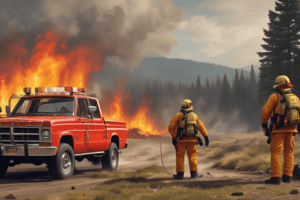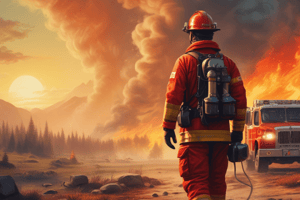Podcast
Questions and Answers
What does the 'C' in the LCES safety procedure stand for?
What does the 'C' in the LCES safety procedure stand for?
- Coordination
- Consolidation
- Communication (correct)
- Control
Which of the following is NOT part of the initial size-up considerations when responding to a fire?
Which of the following is NOT part of the initial size-up considerations when responding to a fire?
- Weather conditions
- Fuels involved
- Firefighter safety
- Local wildlife (correct)
What is the purpose of establishing safety zones?
What is the purpose of establishing safety zones?
- To serve as a water source during the fire
- To facilitate communication with other forces
- To provide a recreational area for firefighters
- To ensure safety for all personnel (correct)
What should the first arriving company officer at a fire do?
What should the first arriving company officer at a fire do?
During a direct attack on a fire, what is the main approach used?
During a direct attack on a fire, what is the main approach used?
Which factor is NOT included in the fire situation information gathered en route to a fire?
Which factor is NOT included in the fire situation information gathered en route to a fire?
What does the 'E' represent in the LCES safety procedure?
What does the 'E' represent in the LCES safety procedure?
In size-up, if flames are reported as 'running', what does this indicate?
In size-up, if flames are reported as 'running', what does this indicate?
What should be included in the safety zones established during wildland incidents?
What should be included in the safety zones established during wildland incidents?
When assessing topography as part of the size-up, which factor is critical?
When assessing topography as part of the size-up, which factor is critical?
Flashcards are hidden until you start studying
Study Notes
Wildland Incident Safety Procedures
- Adhere to the LCES safety procedure: Lookouts, Communications, Escape Routes, Safety Zones
- Post lookouts to monitor potential hazards
- Maintain constant communication with supervisors, crew members, and neighboring forces
- Establish escape routes, ensuring all members are aware of their locations
- Define safety zones that are large enough for all personnel and ensure everyone knows the designated zone
Fire Size-Up and Attack
- Gather information en route:
- Firefighter safety
- Fuel conditions: moisture content, size, shape, fuel loading, horizontal continuity, vertical arrangement
- Weather: temperature, wind speed, relative humidity, predicted weather changes
- Topography: aspect (slope direction), slope steepness, fire location (top, middle, or bottom of slope), terrain shape (narrow canyons, steep slopes)
- Water sources
- Fire access
- Conduct a size-up upon arrival:
- Assess the need for additional resources
- Analyze the fire situation, considering elements such as:
- Fire location and size
- Fuels involved
- Rate and direction of fire spread
- Fire behavior (smoldering, creeping, running, flame heights)
- Special instructions: access points, water sources, hazards, and values at risk
Direct Attack
- Fire control efforts are implemented directly on or near the fire edge.
- Flames can be suppressed using dirt or water, followed by establishing a fire line.
- Alternatively, a fire line is constructed from a safe anchor point, flanking the fire and burning any fuel between the line and the fire edge during line construction.
Studying That Suits You
Use AI to generate personalized quizzes and flashcards to suit your learning preferences.



